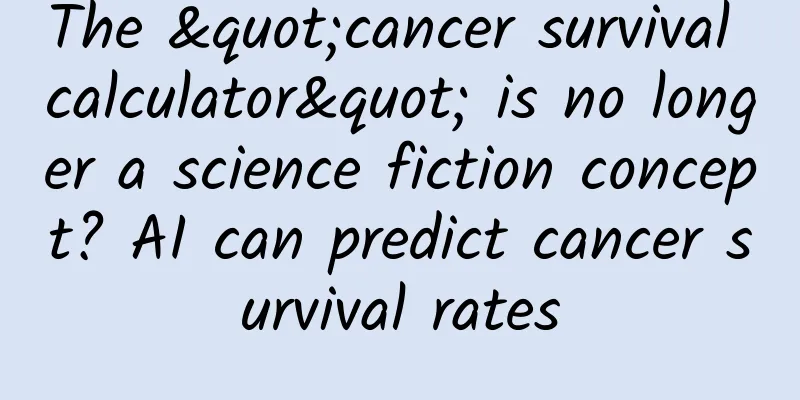The "cancer survival calculator" is no longer a science fiction concept? AI can predict cancer survival rates

|
Audit expert: Zheng Yuanpan, professor at Zhengzhou University of Light Industry "Cancer survival calculator" - this concept that seems to come from a science fiction movie has now become a reality. At the 2023 American College of Surgeons Clinical Congress, researchers from Northwestern University in the United States announced the "Cancer Survival Calculator" they developed. Source: pixabay Imagine that when a patient walks into a hospital and faces a difficult cancer diagnosis, they no longer have to rely solely on the doctor's theory, experience, and guesswork. Now, patients only need to sit in front of an intelligent computer, enter some key medical data, and wait a few seconds to get a relatively accurate cancer survival prediction. This is not just a number, but also a seed of hope, allowing patients to know how far they have to go in their battle against the disease and how to develop a better treatment plan. What does “5-year survival rate” mean? Cancer stages are divided according to the extent to which cancer cells have spread and invaded the body. Staging assessments are based on factors such as the size and depth of the lesion, lymph node involvement, and the presence of distant metastases. Generally speaking, in the early stages of cancer (stages I and II), the tumor is confined to the primary site and has not spread to other tissues or organs. At this stage, the cancer cells have not spread to other parts, the treatment effect is good, and the patient's survival rate is high. Advanced cancer stages (stages III and IV) mean that cancer cells have spread to other parts of the body and may have invaded multiple organs or tissues. In the advanced stages, treatment becomes more difficult and the survival rate is usually lower, but it is still possible to prolong the patient's survival through comprehensive treatment options (such as surgery, radiotherapy, chemotherapy, etc.). Source: pexels The "5-year absolute survival rate" refers to the probability that a cancer patient will survive for at least 5 years from the time of cancer diagnosis. It is one of the important indicators for measuring the effectiveness of cancer treatment and prognosis. Usually, medical research and data statistics calculate the 5-year survival rate for each stage and classify patients according to different cancer stages (such as stage 0, stage I, stage II, etc.). This indicator can help doctors and patients better understand the survival expectations of different stages of cancer and serve as one of the references for evaluating treatment effects and formulating treatment plans. Source: Sohu.com It should be noted that the 5-year survival rate is a statistical data. The actual survival situation may vary due to individual differences and treatment effectiveness, and is affected by many factors , including cancer type, stage, treatment method, and the patient's overall health status. How does the model make statistical predictions? What conclusions can be drawn? During the training process, the machine learning algorithm model will learn based on the existing data, optimize the algorithm, adjust the model parameters, and increase the model's training effect, ultimately enabling the model to achieve its prediction function. In this new study, researchers used machine learning technology to create a prototype cancer survival calculator and tested the tool based on data from the National Cancer Database in 2015 and 2017. These data sets contain a large number of medical records, treatment plans, and follow-up results of patients with breast cancer, thyroid cancer, and pancreatic cancer. The model analyzes and learns from this data to extract features and patterns related to cancer survival. Source: pixabay As the experiment progressed, the researchers found several features that significantly affected the "5-year survival rate." For example, for breast cancer, thyroid cancer, and pancreatic cancer, the patient's age at diagnosis, tumor size, treatment time, and lymph node involvement had the greatest impact on the patient's survival rate. Of course, due to the uniqueness and differences of different individuals, artificial intelligence models cannot replace the role of doctors. Doctors are still decision makers and therapists. They will formulate the best treatment plan for patients based on the results of the calculator and their own clinical experience and expertise. How to prevent cancer? Having said so much, is it possible to solve the problem from the root and prevent cancer in advance? The answer is yes. First of all, long-term smoking is one of the main causes of many cancers, especially secondhand smoke, which greatly increases the risk of cancer. In addition, maintaining a balanced diet is important for cancer prevention. Increase the intake of vegetables, fruits, whole grains and low-fat foods, and reduce the intake of red meat and processed meat. Of course, regular and moderate physical exercise can reduce the risk of cancer. It is recommended to do at least 150 minutes of moderate-intensity aerobic exercise per week, such as brisk walking, running, swimming, etc. Source: pixabay It must be emphasized that regular physical examinations can detect cancer or precancerous lesions early, even congenital hereditary cancers, thereby increasing the chances of cure. We also need to understand that cancer treatment may be a long and difficult process, but it is also very important to maintain a positive attitude and adhere to treatment. The development of artificial intelligence is changing our world, and the medical field is one of the most important parts. The emergence of the "Cancer Survival Calculator" shows us the huge potential and unlimited possibilities of artificial intelligence in the medical field. With the continuous advancement and popularization of artificial intelligence technology, it is conceivable that more similar innovations will emerge. Perhaps in the near future, we will be able to see more medical miracles, and artificial intelligence will eventually become our right-hand man in defeating diseases. |
>>: Quick-freeze mode on! Where does the cold wave come from?
Recommend
A well-known singer fainted due to heat stroke shock. Learn this guide to dealing with heat stroke!
It was reported that singer Eason Chan fainted du...
Don’t ask! Milk tea is for afternoon drinking, people go crazy at night!
Who is the “traffic leader” in the beverage indus...
Computers can't understand the human series in "The Three-Body Problem"? No problem, take a look at this first!
Friends who have read "The Three-Body Proble...
How to manage an event well?
The content of this article is very dry, so it is...
For online operation and promotion, can the hit H5 that goes viral be replicated?
In the past two years, we have seen H5s produced ...
After the Big Bang, there was another Dark Bang…
This is a picture of the galaxy cluster Cl0024+16...
All of Toutiao’s operating strategies are here!
When it comes to traffic, you can’t escape the BA...
How to operate and promote Weibo? 5 tips for Weibo operation and promotion!
Weibo's business model is already quite matur...
Where does the poop on the plane go?
This issue is planned by: Doraemon, Little Dandel...
5 major illusions in the marketing and advertising circles
In the past two years, the crisis awareness of ma...
The super moon will appear! Come and see it tomorrow night
Poster production: Feng Juan According to astrono...
You may be doing these things that your heart fears the most every day!
The heart pumps blood continuously to deliver oxy...
When you are confused about operations, you can use it to find a breakthrough!
A friend who does e-commerce asked on WeChat: &qu...
【Food Information】Food Recipe Tutorial Collection Document
【Food Information】Food recipe tutorial collection...
iOS UIWebView URL interception
When the translator was developing an app, becaus...









